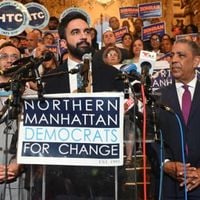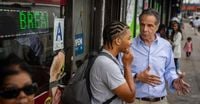New York City’s 2025 mayoral race is shaping up to be one of the most unpredictable contests in decades, as a crowded field of candidates jockeys for endorsements, donor support, and the attention of a restless electorate. In the months since the Democratic primary, the city’s political landscape has been upended by shifting alliances, unconventional campaign strategies, and a growing sense that anything could happen come November.
At the center of the storm is Assemblyman Zohran Mamdani, the Democratic nominee whose campaign has energized the city’s progressive base. According to City & State, Mamdani has amassed an imposing list of endorsements: from high-profile elected officials like Reps. Alexandria Ocasio-Cortez, Jerrold Nadler, Nydia Velázquez, and Adriano Espaillat, to state Attorney General Letitia James, Comptroller Brad Lander, and Public Advocate Jumaane Williams. The support doesn’t stop there—he’s also backed by labor heavyweights such as District Council 37, United Federation of Teachers, and 32BJ SEIU, as well as organizations like the New York Working Families Party and the New York City Democratic Socialists of America.
“The message is Democratic unity ... I’m a Democrat, and I’m inclined to support the Democratic candidate,” Rep. Yvette Clarke initially told NOTUS, though she later clarified to NY1 that she wanted to speak with Mamdani directly before making anything official. As endorsements continue to roll in, the Mamdani campaign is riding a wave of momentum that has turned what might have been a sleepy general election into a full-throated contest over the city’s future.
Yet, in a city where about two-thirds of voters are registered Democrats, the general election is anything but a coronation. Former Governor Andrew Cuomo, after losing the Democratic primary on June 24, has refused to fade quietly into the background. Instead, as The New York Times reports, Cuomo has re-emerged as a third-party candidate, determined to prove that he still has the energy, vision, and clout to win over a skeptical electorate.
Cuomo’s post-primary strategy has been equal parts hustle and reinvention. He’s been spotted at street-side meet-and-greets in neighborhoods across the five boroughs, shaking hands and making his case directly to voters. Fundraisers in the Hamptons have become a fixture of his campaign, as he works to rally the city’s donor class—many of whom remain wary of Mamdani’s democratic socialist platform. The former governor’s social media presence has also taken on a sharper edge, targeting Mamdani for his left-leaning views while trying to present himself as the voice of moderation and experience.
“They are different electorates. There are different issues, there are different moods, there are different candidates,” Cuomo told The New York Times in a recent interview. “I’m a different candidate for having gone through the primary, and I’m a different candidate in the general.”
Despite raising nearly $25 million through a super PAC before the primary, Cuomo’s post-primary fundraising has been sluggish—just $700,000 since June, according to campaign disclosures. Donors, it seems, are waiting to see whether Cuomo can mount a credible challenge before opening their wallets again. “They will make an assessment once the summer is over,” said Ruben Diaz Jr., the former Bronx borough president and a past Cuomo supporter. Diaz, who has since left the super PAC, is now weighing whether to endorse Cuomo or the incumbent, Mayor Eric Adams.
Cuomo’s new campaign style hasn’t gone unnoticed. He’s leaned into more aggressive rhetoric, sometimes even attacking Mamdani for personal choices—like living in a rent-stabilized apartment in Astoria, Queens, which Cuomo argued should have gone to a needier New Yorker. Mamdani fired back, calling Cuomo’s attacks “petty vindictiveness” and blaming the former governor for exacerbating the city’s housing crisis.
Meanwhile, Cuomo has sought support from business leaders and influential groups like the Partnership for New York City, a consortium representing some of the city’s largest corporations and law firms. Fundraisers hosted by figures such as Jimmy Finkelstein and Andrew Stein, both with ties to former President Donald Trump, have added a layer of intrigue to Cuomo’s campaign. Stein, who recently briefed Trump on the race, told The New York Times that Trump’s “heart is still here and he doesn’t want a communist and socialist running the city,” referring to Mamdani. Stein believes Cuomo has the best chance to beat Mamdani, dismissing Adams’ chances outright.
Adams, for his part, is running as an independent after his own primary defeat, but he faces an uphill climb. His endorsements have been more limited, with backing from the NYC Uniformed Forces Coalition 2025—a group of 13 law enforcement, corrections, and sanitation unions—as well as former Governor David Paterson and hedge fund manager Bill Ackman. Some endorsements, such as that of City Council Member James Gennaro, have already been rescinded, reflecting the volatility of the race.
On the Republican side, Curtis Sliwa has locked up support from several elected officials, including Reps. Elise Stefanik and Mike Lawler, as well as the city’s Republican Party organizations. Still, with the city’s strong Democratic lean, Sliwa remains a long-shot contender, though his campaign has found energy among conservative voters who feel alienated by the city’s leftward shift.
As the campaign barrels toward the fall, the dynamics remain fluid. Cuomo’s campaign is betting that if polls tighten and it becomes clear that only he can defeat Mamdani, other candidates like Adams and Sliwa will drop out, allowing him to consolidate support from moderates and business interests. “Cuomo has a base in the Democratic Party, and if he can open up a big tent across all parties, he could pull off an upset,” said pollster Mark Penn, whose firm worked for a pro-Cuomo super PAC during the primary.
But it’s not just about money and endorsements. The campaigns have become a test of messaging and vision, with each candidate trying to define what the next chapter of New York City should look like. Cuomo has organized policy briefings to contrast his vision with Mamdani’s, while Mamdani continues to campaign on a platform of economic and social justice, buoyed by grassroots enthusiasm and union muscle. Adams, meanwhile, is trying to position himself as a pragmatic alternative, touting his record and seeking support from public-sector unions and community groups.
Behind the scenes, the staffing and strategy of the campaigns are also in flux. Cuomo’s inner circle has shrunk since his primary loss, with several top aides departing, though longtime confidantes like Rich Azzopardi and Melissa DeRosa remain. Mamdani has relied on a coalition of progressive organizers and labor strategists, while Adams and Sliwa are both leaning on their networks from previous campaigns.
With the city’s political establishment divided and the electorate restless, the outcome of the 2025 mayoral race is anything but certain. The next few weeks promise more twists, more endorsements, and—if the candidates have their way—a few surprises that could reshape the city’s future for years to come.

